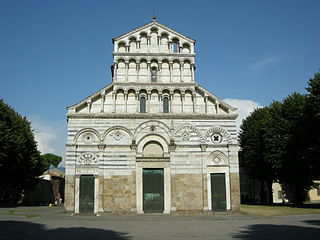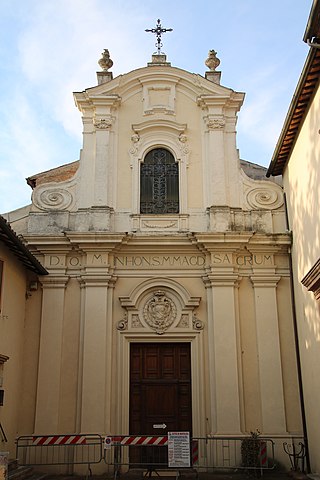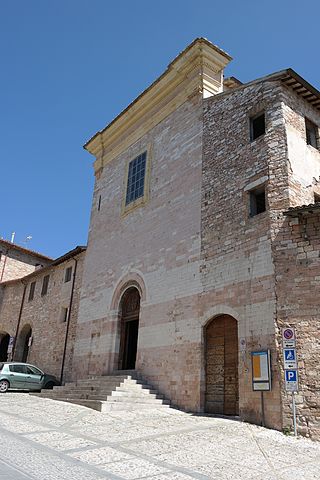
Santa Croce in Fossabanda is a Renaissance-style Roman Catholic church and monastery in Pisa, region of Tuscany, Italy.

Santa Croce in Fossabanda is a Renaissance-style Roman Catholic church and monastery in Pisa, region of Tuscany, Italy.

The region where the monastery was founded had been swampy and dredged initially by the 11-12th-century into a series of moats, hence the name of Fossabandi. [1] [2] By 1238, a Dominican convent had been founded at the site.
In the 14th-century, reconstruction was designed by Bartolomeo da Cantone. From about 1332, the monks began to occupy the safer, central site adjacent to the church of San Silvestro, located inside the city walls. In 1426, the complex was again refurbished, this time under the Franciscan order. [3] A portico was added to the facade, and the cloister was erected. Traces of 16th-century frescoes remain in the lunettes of the cloister.
The church contain a canvas of the Madonna and Child with Angelic Musicians by the early 15th-century painter Alvaro Pirez di Evora. [4] On the lateral altars are paintings St Francis and a Child and Angel and Madonna(1649) by Jacopo Vignali. Other works are a Blessed Salvatore da Orta Franciscan cures the ill and sick (circa 1606) by Paolo Guidotti and a St Francis prays before the Apparition of Christ and the Madonna (after 1627) by Francesco Curradi. It holds a wooden crucifix from the 15th century.
Previously a chapel held an altarpiece was a St John the Baptist by Clemente Bocciardi. [5] A Madonna and Child with Saints Antony Abbot, Pope Gregory, John the Baptist, and Francis is now displayed in the Museo di San Matteo.
In 1810, Napoleonic governments suppressed the monastery. A Coronation of the Virgin (1474) was looted by Napoleonic forces and is now in the Dijon Museum. By 1875, the convent had been expropriated and was used as a Lazzaretto during the cholera epidemic of that year. The cloister is now a hotel.


The Basilica di Santa Croce is a minor basilica and the principal Franciscan church of Florence, Italy. It is situated on the Piazza di Santa Croce, about 800 metres southeast of the Duomo, on what was once marshland beyond the city walls. Being the burial place of notable Italians, including those from the Italian Renaissance such as Michelangelo, Galileo, and Machiavelli, as well as the poet Foscolo, political philosopher Gentile and the composer Rossini, it is also known as the Temple of the Italian Glories.

San Damiano is a church with a monastery near Assisi, Italy. Built in the 12th century, it was the first monastery of the Order of Saint Clare, where Saint Clare built her community.

Sant'Onofrio al Gianicolo is a titular church in Trastevere, Rome. It is the official church of the papal order of knighthood Order of the Holy Sepulchre. A side chapel is dedicated to the Order and a former grand master, Nicola Canali is entombed there. It is located on the Janiculum. Since 1946, the church has been under the care of the American congregation of the Franciscan Friars of the Atonement.

San Paolo a Ripa d'Arno is a Roman Catholic church in Pisa, region of Tuscany, Italy. It is a pre-eminent example of Tuscan Romanesque church architecture. The church is also locally known as Duomo vecchio.

Santa Cristina is a Neoclassical-style, Roman Catholic church in Pisa, region of Tuscany, Italy. It is located on the Lungarno Gambacorti.

Santa Caterina d'Alessandria is a Gothic-style Roman Catholic church in Pisa, Tuscany, Italy.

The Minor Basilica of Santi Vicenzo e Caterina de' Ricci is a Catholic church, built in the 16th to 18th centuries, and located in the town of Prato, in Tuscany, Italy. Adjacent to the church is a 16th-century monastery.

Santa Maria Maddalena, also called the Chiesa della Beata Mattia is a Baroque-style, Roman Catholic church and monastery located on a cul de sac of Via Beata Mattia #39, where it intersects with Via Damiano Chiesa, in Matelica, province of Macerata, region of Marche, Italy.

San Francesco is a Romanesque-Gothic style, Roman Catholic church and Franciscan monastery located on Via San Francesco d'Assisi in central Brescia, region of Lombardy, Italy.
Sant'Agostino is a Roman Catholic church, located on Via Cavour in Mondolfo, region of Marche, Italy.

San Francesco is a Gothic-style, Roman Catholic, Franciscan church in Cagli, province of Pesaro e Urbino, region of Marche, Italy.

The Monastery of San Girolamo in Campansi is a former convent located on Via Campansi #18 in the city of Siena, region of Tuscany, Italy. The Baroque-style church still stands as an independent chapel; while the monastery has been converted to a nursing home for the elderly. There is a separate Monastery of San Girolamo on via San Girolamo, located in a different contrada of Siena.
San Torpé is a Roman Catholic church located in Largo del Parlascio #20 in the town of Pisa, region of Tuscany, Italy.

The Treasure Museum of the Basilica of Saint Francis contains a collection of sacred art that is on display in two halls found on the northern side of the Cloister of Pope Sixtus IV which is part of the Sacro Convento in Assisi, Italy. The entrance is found on the second level of the Renaissance cloister behind the apse of the Basilica of Saint Francis, which houses the remains of St. Francis of Assisi. Since 1986 the museum has also displayed a collection of works donated to the Conventual Franciscan Friars by the Secular Franciscan and American art critic, Frederick Mason Perkins, who died in Assisi in October 1955.

Sant’Andrea is a 14th-century church located in Spello, province of Perugia, region of Umbria, Italy.
Sant’Antonio al Monte is a Franciscan church and convent, located just outside the city of Rieti, in the province of Rieti, region of Lazio, Italy.
San Paolo is a Roman Catholic church and former monastery in the town of Poggio Nativo, province of Rieti, Region of Lazio, Italy.
The Pinacoteca Comunale of the town of Nocera Umbra is located in the former church of San Francesco, located on Piazza Caprera #2 in this town in the region of Umbria, Italy.

Santa Croce is a Gothic style, Roman Catholic church in Piazza Mazzini, in the center of Bastia Umbra, in the region of Umbria, Italy.

Santa Maria Maggiore is a former Catholic church, now deconsecrated, in the sestiere of Santa Croce, Venice. The church, which was completed at the start of the 16th century, as part of a convent, was suppressed and deconsecrated during the decade of the Napoleonic Kingdom of Italy. It has since has been used as a stable, and a tobacco warehouse, before forming part of the Santa Maria Maggiore prison.
![]() Media related to Santa Croce in Fossabanda (Pisa) at Wikimedia Commons
Media related to Santa Croce in Fossabanda (Pisa) at Wikimedia Commons